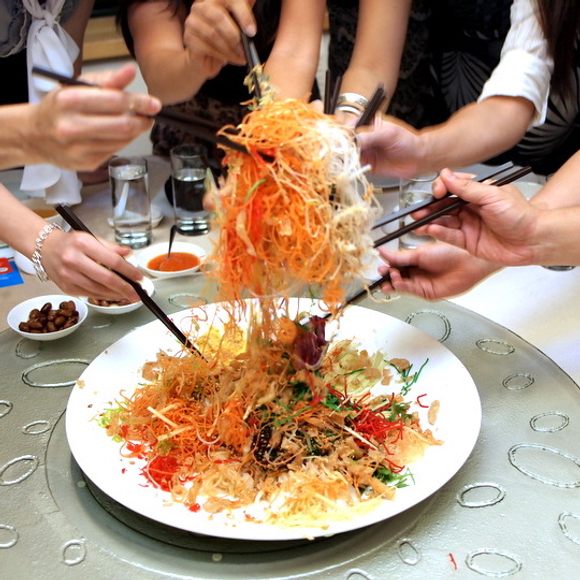In Malaysia and Singapore, revelers welcome Chinese New Year by tossing yusheng (yee sang in Cantonese), a sweet and tangy raw fish salad. The colorful dish includes strips of raw fish, often salmon, mixed with shredded vegetables and drizzled with various sauces and condiments.
The name of the dish is highly symbolic and involves plays on homophones. Yu is the Chinese word for fish, but also sounds like the word for abundance. Yu sheng, which literally translates to “raw fish,” also sounds like the Chinese phrase for an “increase in abundance,” and so offers the dish a connotation of abundance and prosperity. Some of the ingredients in the dish also carry deeply symbolic meanings based on popular Chinese sayings: lime for luck, peanut crumbs to symbolize gold and silver, green radishes for eternal youth, and shredded white radish for prosperity in the workforce, among a multitude of other ingredients.
Yusheng is consumed as an appetizer, and can be eaten on any day of the Chinese New Year, which runs from the first to the 15th day of the first lunar month. Each ingredient is added one by one to the dish, and with each addition, the salad-maker says a well-wishing phrase. Once all the ingredients have been placed in the dish, all diners stand up and toss the ingredients into the air while saying “lo hei,” a Cantonese phrase that conveys an auspicious wish for the New Year. It’s said that the higher one tosses, the higher the diner’s fortune will be for that year.
The origins of this dish are murky, as no one is completely sure where it was created. The popular iteration known as fa cai yu sheng (or “prosperity raw fish salad”) is said to have been invented in the 1960s in Singapore, but other sources have claimed that it was invented in the state of Negeri Sembilan in Malaysia in 1947. Early versions of the salad are even thought to have roots in southern China, but today the cultural dish is usually found only in southern Malaysia and Singapore. It has since been named a Malaysian heritage food by the Malaysian Department of National Heritage.
Where to Try It
-
This chain serves up yusheng each New Year. It costs around $30.
-
Jumbo Seafood
Block 1206 East Coast Parkway #01-07/08, East Coast Seafood Centre, Singapore, 449883, SingaporeThis Singapore spot offers yusheng, among other Chinese New Year delicacies. Note: The salad is quite large and costs around $60. Book a table in advance on their website: jumboseafood.com.sg.
Written By
 samanthachong
samanthachong
Sources
- my.asiatatler.com/dining/yee-sang-101-why-we-toss-what-does-it-symbolise
- www.placesandfoods.com/2013/02/the-origins-of-yee-sang.html
- thecoverage.my/lifestyle/6969/
- web.archive.org/web/20150402145156/www.heritage.gov.my/index.php/en/heritage-register/national-heritage-register-list/object/intangible-heritage-object














